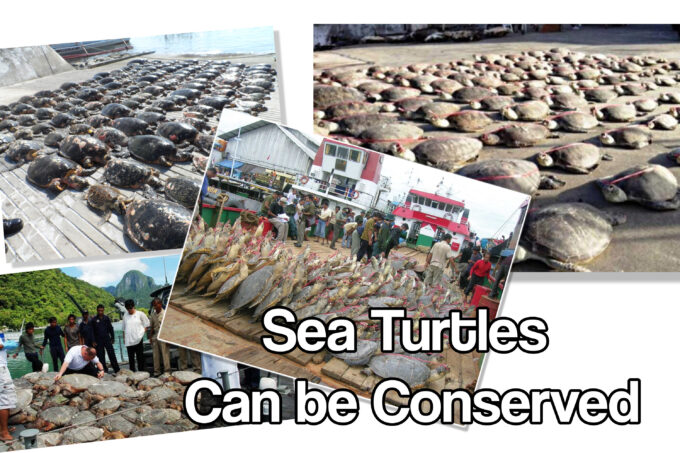Conserving SeaTurtles in Fresh Water – It Can and Should Be Done.
The TL;DR – Sea Turtles can survive and thrive in fresh water. They would be safe from a globe full of fishermen who harvest as many as they can catch. Breeding sea turtles could at LEAST be done artificially but it’s possible they can learn to reproduce on artificial beaches. Feeding sea turtles would require manmade feed. Space needed for sea turtles would be large lakes. Impact on the environment could be gauged in smaller private lakes and bodies of water. (Bibliography)
Since I was in my teens I’ve dreamed of rearing Sea Turtles in fresh water. I always thought it was possible and now I know that it is. My first exposure to that reality was a side show in Florida. A man had a Sea Turtle swimming around in an above-ground swimming pool in fresh water. Apparently he did not know they only lived in salt water.
The turtle had been captive (on display) for at LEAST five years in exclusively fresh water eating bits of fish, and probably dog food.
Two other cases of Sea Turtles that “got lost” in fresh water ponds, and which swam up the Potomac to happily swim around for an undetermined amount of time prove that freshwater does not kill Sea Turtles. These cases are described in the limited bibliography below. (Bibliography)
Reasons that Chat GPT AI Generated articles conclude that Sea Turtles can’t survive in fresh water:
- Kidneys are engineered to handle tons of salt.
- The Sea Turtle is engineered for Salt Water
- There’s no mollusks, lobster, jelly fish in Freshwater.
- Freshwater pollution is bad for them
- Freshwater predators & diseases are unknown to them.
- Marine water is optimal for them.
And that’s LITERALLY all there is.
These push backs are SURMOUNTABLE entirely. For example we can FEED the Sea Turtles in the habitat / conservatory.We can conserve them against other turtles and predators. We can control certain environmental conditions including heat and alkalinity.
Let’s look at that list again:
- Kidneys are engineered to handle tons of salt. (But they can handle fresh water just fine if acclimated)
- The Sea Turtle is engineered for Salt Water (And a cactus is engineered for the desert but can live in a house)
- There’s no mollusks, lobster, jelly fish in Freshwater. (Sea Turtle Food would not be challenging to manufacture)
- Freshwater pollution is bad for them (Wild in freshwater, MAYBE but no more deadly than a boat load of hungry fishermen in Manila)
- Freshwater predators & diseases are unknown to them. (This would require initial quarantine and experimentation but their worst predators and diseases would actually be ABSENT.)
- Marine water is optimal for them. (No evidence suggests that Fresh Water couldn’t be as good or better)
Would You Be Risking Threatened, Wild Sea Turtles to Your Experiment?
NO not at all.
Every Sea Turtle in the conservatory could be purchased from a turtle farm in the Caymans. NO WILD TURTLES WOULD BE RISKED. (Where the turtles would come from)
The advantages would be numerous
- Turtles would start out young and adapt to freshwater more easily
- Bouyancy issues would be easier on the animals practically raised in fresh water
- Adaptation to new (commercial prepared Mazuri) food would be smoother for young turtles
- Breeding would be several years off while the Conservatory developed the needed infrastructure, technique and experience.
We would need:
- Mazuri Feeds to design and produce a food for the Sea Turtles
- Blink or Ring or similar to provide cameras to detect human and other predators and provide an early warning.
- DJI to provide a few drones for capturing images of thieves, predators and announcing their location to law enforcement
- Fiberglass inground and aboveground pools for the young turtles being prepared / acclimated to the facilities.
- A front end loader to engineer and build the holding water for the young turtles.
- Acres and acres of fresh water land in Southern Florida so that the turtles could receive the correct temperatures and light.
- Sand for artificial beaches
- Incubation and Hatchery equipment
- Invitation to any Sea Turtle conservationists , marine biologists or similar to advise on all things “Sea Turtle”.
Will this ever happen?
Almost certainly not. Mankind has a tendency to “extinct” animals. And so far the only animals that have survived that are FARMED and IMPORTANT.
It is ABSOLUTELY probable that in the interest of keeping NO SEA TURTLE IN CAPTIVITY, the powers-that-be will (in the Big Picture) condemn the species’ to death at the hands of fishermen across the globe even while saving “one nest at a time” on Florida beaches.
The Sea Turtle Farm in the Caymans is (to me) the ONLY hope for long range sea turtle survival by attaching economic import and success to SeaTurtle culture. Unfortunate that there isn’t safe “room” in nature for these animals but we can cry about that all we want. It doesn’t stop those thousands of little boats with fishermen harvesting as many as they can catch and laundering them through Hong Kong.
Turtle Debate- Can Sea Turtles Live In Freshwater- – MarinePatch
Can sea turtles live in freshwater- [Answered]
Can Sea Turtles Live in Freshwater- A Comprehensive Guide – Tortoise Website






